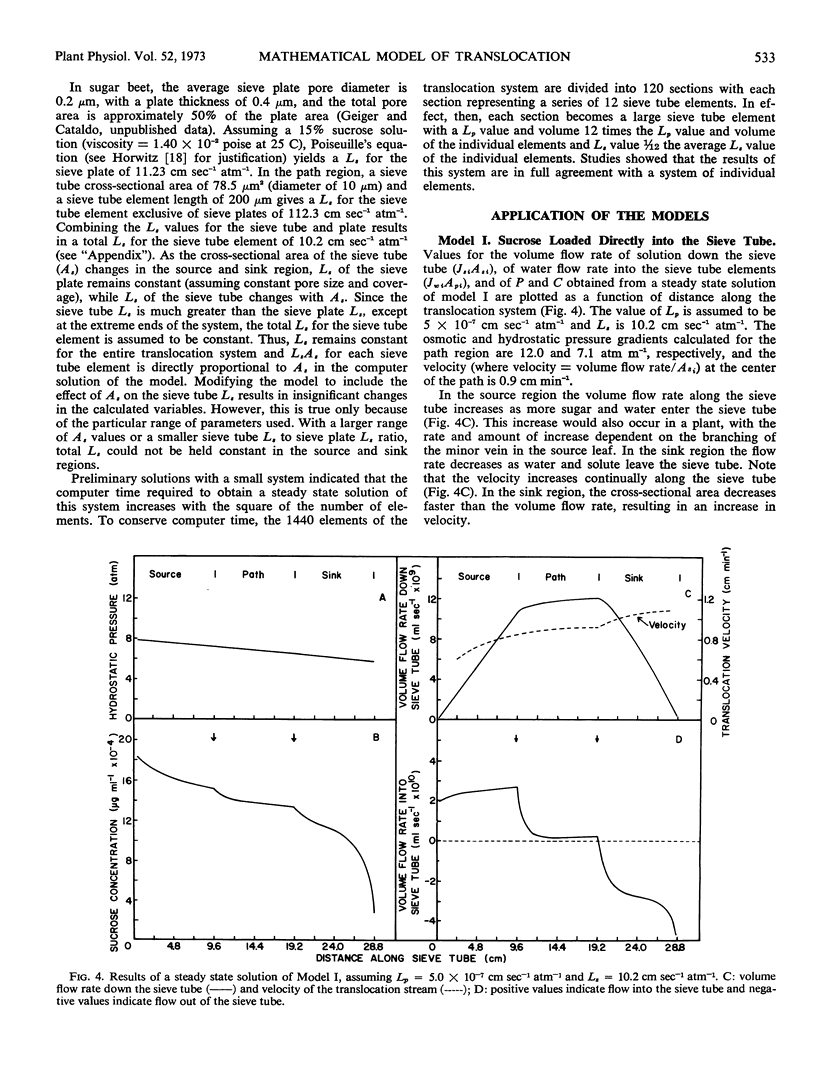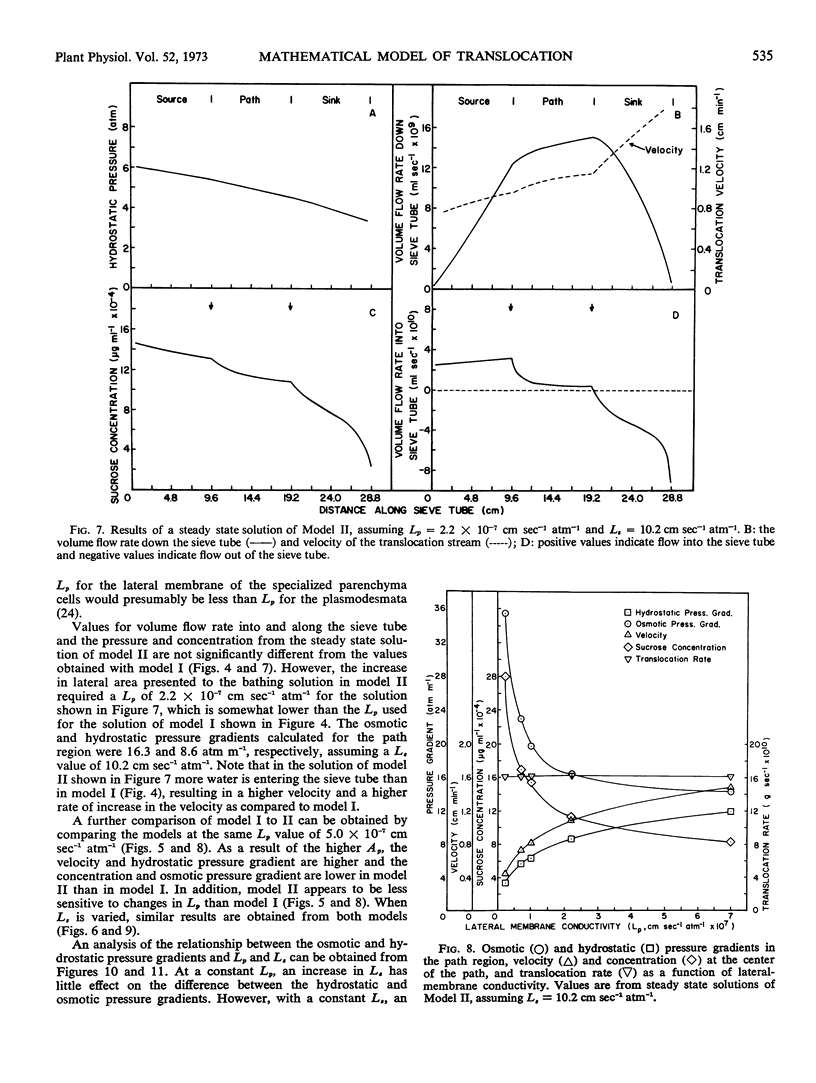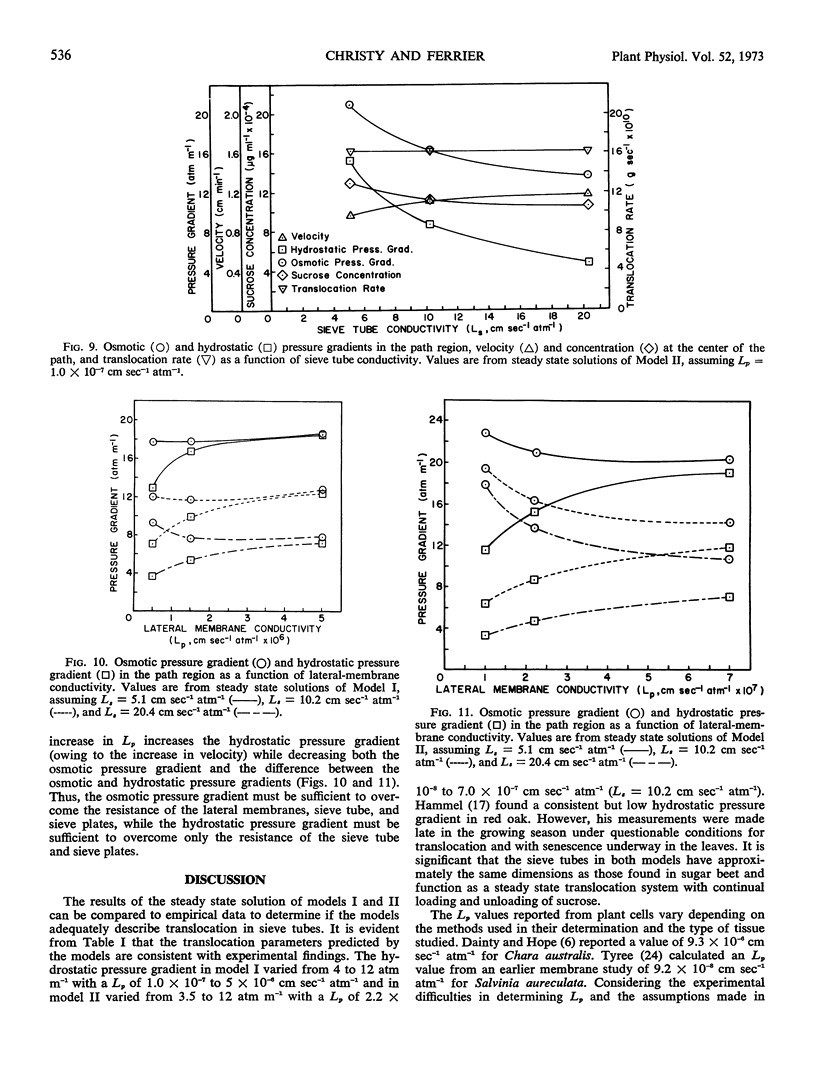Abstract
The steady state solutions of two mathematical models are used to evaluate Münch's pressure-flow hypothesis of phloem translocation. The models assume a continuous active loading and unloading of translocate but differ in the site of loading and unloading and the route of water to the sieve tube. The dimensions of the translocation system taken are the average observed values for sugar beet and are intended to simulate translocation from a mature source leaf to an expanding sink leaf. The volume flow rate of solution along the sieve tube, water flow rate into the sieve tube, hydrostatic pressure, and concentration of sucrose in the sieve tube are obtained from a numerical computer solution of the models. The mass transfer rate, velocity of translocation, and osmotic and hydrostatic pressures are consistent with empirical findings. Owing to the resistance to water flow offered by the lateral membranes, the hydrostatic pressure generated by the osmotic pressure can be considerably less than would be predicted by the solute concentration. These models suggest that translocation at observed rates and velocities can be driven by a water potential difference between the sieve tube and surrounding tissue and are consistent with the pressure-flow hypothesis of translocation.
Full text
PDF







Selected References
These references are in PubMed. This may not be the complete list of references from this article.
- Cronshaw J., Anderson R. Sieve plate pores of Nicotiana. J Ultrastruct Res. 1969 Apr;27(1):134–148. [PubMed] [Google Scholar]
- Fife J. M., Price C., Fife D. C. Some properties of phloem exudate collected from root of sugar beet. Plant Physiol. 1962 Nov;37(6):791–792. doi: 10.1104/pp.37.6.791. [DOI] [PMC free article] [PubMed] [Google Scholar]
- Fisher D. B. Kinetics of C-14 Translocation in Soybean: III. Theoretical Considerations. Plant Physiol. 1970 Feb;45(2):119–125. doi: 10.1104/pp.45.2.119. [DOI] [PMC free article] [PubMed] [Google Scholar]
- Geiger D. R., Cataldo D. A. Leaf structure and translocation in sugar beet. Plant Physiol. 1969 Jan;44(1):45–54. doi: 10.1104/pp.44.1.45. [DOI] [PMC free article] [PubMed] [Google Scholar]
- Geiger D. R., Saunders M. A., Cataldo D. A. Translocation and accumulation of translocate in the sugar beet petiole. Plant Physiol. 1969 Dec;44(12):1657–1665. doi: 10.1104/pp.44.12.1657. [DOI] [PMC free article] [PubMed] [Google Scholar]
- Geiger D. R., Sovonick S. A. Temporary inhibition of translocation velocity and mass transfer rate by petiole cooling. Plant Physiol. 1970 Dec;46(6):847–849. doi: 10.1104/pp.46.6.847. [DOI] [PMC free article] [PubMed] [Google Scholar]
- Hammel H. T. Measurement of turgor pressure and its gradient in the Phloem of oak. Plant Physiol. 1968 Jul;43(7):1042–1048. doi: 10.1104/pp.43.7.1042. [DOI] [PMC free article] [PubMed] [Google Scholar]
- Horwitz L. Some Simplified Mathematical Treatments of Translocation in Plants. Plant Physiol. 1958 Mar;33(2):81–93. doi: 10.1104/pp.33.2.81. [DOI] [PMC free article] [PubMed] [Google Scholar]
- Trip P. Sugar transport in conducting elements of sugar beet leaves. Plant Physiol. 1969 May;44(5):717–725. doi: 10.1104/pp.44.5.717. [DOI] [PMC free article] [PubMed] [Google Scholar]
- Tyree M. T. The symplast concept. A general theory of symplastic transport according to the thermodynamics of irreversible processes. J Theor Biol. 1970 Feb;26(2):181–214. doi: 10.1016/s0022-5193(70)80012-1. [DOI] [PubMed] [Google Scholar]
- Weatherley P. E., Johnson R. P. The form and function of the sieve tube: a problem in reconciliation. Int Rev Cytol. 1968;24:149–192. doi: 10.1016/s0074-7696(08)61399-6. [DOI] [PubMed] [Google Scholar]


